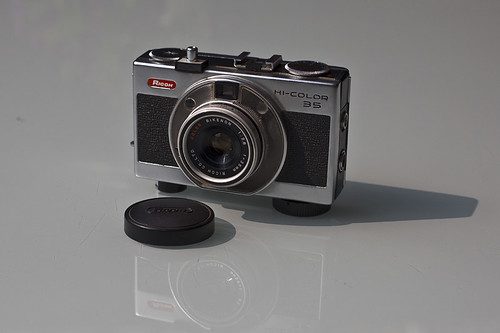Difference between revisions of "Ricoh Hi-Color 35"
m (Minor clarification re two versions of the Hi-Color 35) |
m (Corrected heading) |
||
| Line 6: | Line 6: | ||
| image_by= Mark Verlijsdonk | | image_by= Mark Verlijsdonk | ||
|image_rights= with permission | |image_rights= with permission | ||
| − | + | }} | |
The '''Ricoh Hi-Color''' is a viewfinder camera for [[35mm film]] first sold in 1968. There were several variations, with the key differences: | The '''Ricoh Hi-Color''' is a viewfinder camera for [[35mm film]] first sold in 1968. There were several variations, with the key differences: | ||
| Line 26: | Line 26: | ||
The USA Retail price in 1970 was $74 USD.<ref>[http://books.google.com/books?id=8dcDAAAAMBAJ&lpg=PA144&dq=%22lenco%20photo%20products%22&pg=PA144#v=onepage&q=%22lenco%20photo%20products%22&f=false Popular Mechanics, May 1970, p 144, Low-Cost Rapid-Fire Camera] (second version Hi-Color 35)</ref> | The USA Retail price in 1970 was $74 USD.<ref>[http://books.google.com/books?id=8dcDAAAAMBAJ&lpg=PA144&dq=%22lenco%20photo%20products%22&pg=PA144#v=onepage&q=%22lenco%20photo%20products%22&f=false Popular Mechanics, May 1970, p 144, Low-Cost Rapid-Fire Camera] (second version Hi-Color 35)</ref> | ||
| − | == | + | ==Notes== |
<references /> | <references /> | ||
Revision as of 05:28, 25 February 2019

|
| Ricoh Hi-Color 35 (second version with hot shoe) image by Mark Verlijsdonk (Image rights) |
The Ricoh Hi-Color is a viewfinder camera for 35mm film first sold in 1968. There were several variations, with the key differences:
- the Hi-Color was the only model with a front-of-body shutter release,
- the Hi-Color 35 has a top plate shutter release (There were two versions. Later models had a hot shoe while the early ones had no accessory shoe.),
- the Hi-Color 35 S has a self-timer,
- the Hi-Color 35 BT was all black and had a more trapezoidal body shape.
What all models had in common were:
- a CdS meter,
- shutter priority automatic exposure plus manual exposure control,
- and spring powered motor drive.
The viewfinder comprises two objective lenses, an eyepiece, and two prisms in a double Porro formation [1], as found in binoculars.
One winding of the motor drive spring is sufficient for 15 exposures, which can be taken in rapid succession at the rate of one frame per second.
The USA Retail price in 1970 was $74 USD.[2]
Notes
- ↑ A geometric prism with right-angled triangular end faces, such that light enters the rectangular face of the prism, is reflected twice from the sloped faces, and exits again through the large rectangular face. Because the image is reflected twice, it is not left/right reversed.
- ↑ Popular Mechanics, May 1970, p 144, Low-Cost Rapid-Fire Camera (second version Hi-Color 35)
Links
- Ricoh Hi-Color 35 page at Camera Portraits